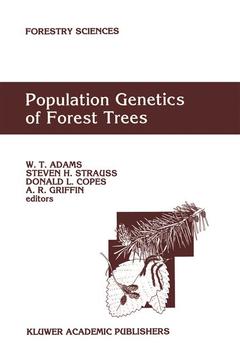Population Genetics of Forest Trees, 1992 Proceedings of the International Symposium on Population Genetics of Forest Trees Corvallis, Oregon, U.S.A., July 31-August 2,1990 Forestry Sciences Series, Vol. 42
Langue : Anglais
Coordonnateurs : Adams W.T., Strauss Steven H., Copes Donald L., Griffin A.R.

Tropical climates, which occur between 23°30'N and S latitude (Jacob 1988), encompass a wide variety of plant communities (Hartshorn 1983, 1988), many of which are diverse in their woody floras. Within this geographic region, temperature and the amount and seasonality of rainfall define habitat types (UNESCO 1978). The F AO has estimated that there 1 are about 19 million km of potentially forested area in the global tropics, of which 58% were estimated to still be in closed forest in the mid-1970s (Sommers 1976; UNESCO 1978). Of this potentially forested region, 42% is categorized as dry forest lifezone, 33% is tropical moist forest, and 25% is wet or rain forest (Lugo 1988). The species diversity of these tropical habitats is very high. Raven (1976, in Mooney 1988) estimated that 65% of the 250,000 or more plant species of the earth are found in tropical regions. Of this floristic assemblage, a large fraction are woody species. In the well-collected tropical moist forest of Barro Colorado Island, Panama, 39. 7% (481 of 1212 species) of the native phanerogams are woody, arborescent species (Croat 1978). Another 21. 9% are woody vines and lianas. Southeast Asian Dipterocarp forests may contain 120-200 species of trees per hectare (Whitmore 1984), and recent surveys in upper Amazonia re corded from 89 to 283 woody species ~ 10 cm dbh per hectare (Gentry 1988). Tropical communities thus represent a global woody flora of significant scope.
Dedication.- Keynote paper.- Genetic diversity - seeing the forest through the trees.- Assessment of genetic diversity within and among species.- Genetic variation within European tree species.- Patterns of genetic diversity in Australian tree species.- Isozyme variation in tropical trees: patterns of genetic organization.- Factors influencing levels of genetic diversity in woody plant species.- Biosystematics and adaptive significance of biochemical markers.- Biochemical and molecular genetic markers in biosystematic studies of forest trees.- Applications of terpene analysis in forest genetics.- Evidence for the adaptive significance of allozymes in forest trees.- Mating systems, gene dispersal, and genetic structure within populations.- The dynamic mating systems of conifers.- Gene dispersal within forest tree populations.- Gene flow among seed plant populations.- Spatial structure of genetic variation within populations of forest trees.- Application of biochemical markers in forest management.- Allozyme markers in breeding zone designation.- The use of electrophoretic markers in seed orchard research.- Effect of forest management on gene pools.- Allozyme markers in forest genetic conservation.- DNA as a biochemical marker.- Nuclear, chloroplast, and mitochondrial DNA polymorphisms as biochemical markers in population genetic analyses of forest trees.- Use of DNA markers in forest tree improvement research.- Commentary.- A commentary on current approaches to forest population genetics.
Date de parution : 10-2012
Ouvrage de 423 p.
16x24 cm
Thèmes de Population Genetics of Forest Trees :
Mots-clés :
DNA; Tree; evolution; evolutionary biology; forest trees; genes; genetics; systematics; Tree Biology
© 2024 LAVOISIER S.A.S.



